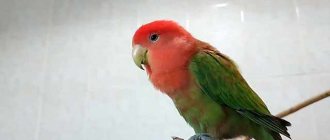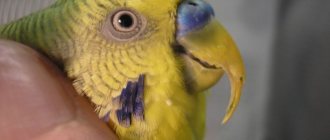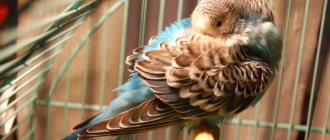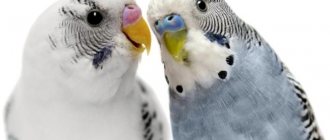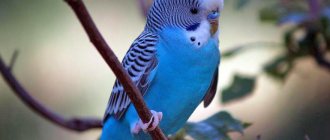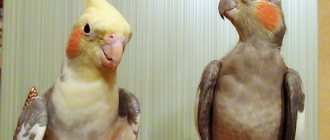If you often communicate and play with your winged pets, then you know their habits well. Then you can easily detect any change in their behavior. If the feathered interlocutor behaves differently than usual, then something has happened. Therefore, you do not need to be an expert in diagnosing a specific disease in budgies. If you see that your parrot's behavior has changed, it is most likely sick.
Checking the health of budgerigars
If you keep many budgies in an aviary, it will be more difficult to identify individual problems. So always be on your guard. Like many animals, budgies are excellent at hiding their illnesses. They can do this until the disease reaches critical stages. This makes sense in the wild. After all, predators quickly spot easy prey. And a sick-looking bird will be an easy target for them. Therefore, budgerigars carefully hide their health problems.
Once you have determined that your bird is sick, go to the veterinarian as soon as possible. The person you contact should be a bird expert, that is, an ornithologist. If your veterinarian tells you that there is no point in treating small birds such as budgies, choose another specialist. This statement is not true; birds can be treated. This happens because most veterinarians prefer to treat cats and dogs.
Avitaminosis
Quite a common occurrence. Bird owners, perhaps unknowingly, feed their parrots the same food mixture. Over time, the singing pet’s body becomes depleted and critically lacks vitamins. A lack of vitamin B is manifested by the following symptoms - the parrot loses its orientation. It is difficult for him to fly and stay on the perch. Next, neck spasms and head twitching will begin. If action is not taken, the bird will die.
This vitamin is important for the nervous system and metabolic processes of birds. Veterinarians recommend supplementing the wavy with brewer's yeast for some time. They can be purchased at any veterinary pharmacy or pet store.
Self-examination
If you spend time with your feathered friend, then you know what a healthy budgie looks like. Then any change in your bird's appearance or behavior will not escape your attention. There are many diseases that can affect budgies. You are required to watch the birds and talk to an ornithologist. As soon as you notice any problems, from a broken wing to mild lethargy, contact an ornithologist immediately.
You can also carefully examine your pet yourself to check for problems such as wounds and lice. It is quite easy to persuade a tame bird to sit on your hand. Once there, carefully pick it up and inspect it as quickly as possible so as not to disturb it too much.
Where to expect trouble?
Wild lovebirds are constantly on the move, maintaining a high metabolic rate in their bodies. Domesticated parrots fly only when they have the opportunity, and spend the rest of their lives in a cage.
If birds are deprived of the opportunity to fly freely around the room, their metabolic processes begin to change, thereby reducing immunity. As a result, the parrot’s body is susceptible to various diseases.
The immune system of lovebirds is weakened by disruptions in sleep patterns, unsuitable climate in the room where they live, and a small cage.
In addition to improper maintenance, many bird diseases can be caused by poor care: unsanitary conditions in the cage, lack of water and hygiene procedures, monotonous diet.
Even a healthy lovebird runs the risk of getting sick. For example, he can become infected from wild birds with which he may come into contact while in a cage on the balcony, or from a new parrot that has not undergone quarantine for forty days.
Diseases of lovebirds can be divided into two groups: not dangerous for other birds and dangerous, and sometimes for people.
Let's take a closer look at what to expect from this or that disease, and how to deal with it.
Symptoms of budgerigar disease
The following signs indicate the presence of the disease.
Lethargy
Even the most timid of budgies cannot spend long periods of time in silence and stillness. Unless, of course, they are sleeping. If a bird sits in silence for a long time, it has no interest in you, new food, its mate and other things, then it is sick. In addition to the fact that you have a lethargic budgie, there may be other signs: the pet is ruffled, has ruffled feathers, does not eat or drink, etc.
Daytime nap
It may be due to external interference at night. But if you can rule it out, lethargy is a symptom of budgie disease. One of the reasons may be an infestation with feather mites. These bloodsuckers will not allow you to get a good night's sleep.
Ruffled Feathers
This means the bird is frozen. Reasons: cold cage or aviary, budgerigar is unhealthy. A frozen budgie may also shiver.
High-pitched scream
If your bird is constantly calling in alarm, it is in trouble. There can be 2 situations here:
- Someone or something nearby is bothering the bird.
- The bird is in pain.
There may be no visible symptoms of budgie disease. However, if you are sure that there is no one or anything nearby that could cause concern, then your pet is sick.
Doesn't sit like it used to
The bird may suddenly begin to rest on the ground or tray rather than on the perch. In this case, she either damaged her wing or was too weak to sit on the perch. Another, less serious sign of problems is when a parrot who always sleeps on one leg starts sleeping on both legs.
Dirty next to the cesspool
This is always a sign of loose or sticky droppings (diarrhea), which usually indicates a health problem.
Read here what to do if your budgie has abnormal droppings, diarrhea or constipation.
Refusal to eat
Some reasons why a budgie won't eat or drink:
- problems with the gastrointestinal tract,
- poisoning,
- bruises,
- poor quality food,
- difficulties with adaptation to a new place.
Sleep rules
Like any living creature, budgies prefer to sleep at night. They do this not under a warm blanket and on a soft bed. Birds prefer to rest on a branch, standing on one leg. This is necessary for proper rest. Young individuals sleep on two legs, this is due to the fact that their coordination is poorly developed and it is difficult for them to maintain balance on one limb.
Even budgerigars, when resting, turn their heads behind their backs and hide their beaks in a feather. This is how birds stay warm throughout their sleep. After a person falls asleep, it is difficult for him to maintain the warmth of his body; a blanket is used to maintain the desired temperature. In domestic parrots, this protection is provided by their own feather.
In their natural environment, budgies also sleep at night. The crown of trees is used for sleeping. The branches create a barrier for predators who want to feast on small birds. During the day they also rest, but this does not last long, 20-30 minutes. Most often, parrots sleep during the hottest hours of the day, hiding in the shade of foliage. For proper rest, a parrot needs to rest 10-15 hours a day.
But poultry's life schedule does not always coincide with human sleep time. For example, with the first rays of the sun, a budgie will also wake up and chirp. Such songs can irritate apartment dwellers. That is why it is recommended to cover the cage with your feathered pet with a dark blanket at night. This way you can simulate night and avoid waking up in the early morning hours.
Caring for the health of a sick budgie
A sick bird should be shown to an ornithologist. Separate him from other parakeets to avoid spreading the disease. Also clean the cage. To do this, use a pet-safe disinfectant or a mixture of one part vinegar to two parts water.
There are a few other things you can do to keep your budgie comfortable before your veterinarian appointment.
- Set up a solitary cage in a familiar environment for the bird. This way you can reduce stress from new living conditions.
- Make sure the cage is warm. Most diseases appear due to low temperatures. Sudden cold can even lead to death.
- The cage should have a drinking bowl with fresh water. Also offer your sick budgie his favorite food.
- Do not allow children or pets to fuss around the bird. Keep her in a crate to avoid additional stress.
Poisoning
Poisoning occurs due to poor quality food, dirty water or cage. Intoxication of the body occurs when eating poisonous plants or other substances. After drinking alcohol or pecking on a cigarette filter, salt, zinc and lead. You can detect that a bird has been poisoned by looking at its droppings; their color changes. The bird feels sick and vomits. He will refuse to eat, his feathers will be ruffled and ruffled.
The parrot does not maintain balance, so it will sit in the cage, leaning firmly on both legs. You can help him by giving him sorbents - activated carbon, Enterosgel, Sorbex, Atoxil and other drugs. They are introduced into the beak using a pipette or syringe (without a needle!). Then give laxatives and antiemetics. Be sure to drink plenty of fluids to avoid dehydration.
Diseases of budgies
Budgerigars are relatively tough birds, but can still fall victim to a wide range of diseases. Always consult a veterinary expert for an accurate diagnosis. Your job as a budgie owner is to recognize the disease in general terms. The points listed in the symptoms of budgie disease above will help you with this.
Megabacteriosis (macrorhabdosis)
This is a highly contagious infection. It is extremely difficult to detect in the early stages. Megabacteriosis appears and develops in the body of a bird without any external signs of disease. The first thing you may notice is that your budgie is losing weight. However, despite this, he will continue to eat food with pleasure. The fact is that megabacteriosis complicates the digestion process. In addition, you may find undigested food in the droppings. The bird may also vomit food and mucus. The parrot will also have lethargic behavior.
Until 2004, the cause of the disease was considered to be a bacterium. But it has now been established that the disease is caused by a yeast fungus. Latin name: Macrorhabdus ornithogaster. The misdiagnosis was due to bacteria, including streptococci, taking advantage of the budgie's weakened immune system and spreading a secondary infection. The combination of yeast and bacterial attack leads to complete loss of strength, emaciation, and atrophy.
Now about how to treat a budgie with such a disease. First of all, you need to see a doctor. Your veterinarian will prescribe medication to combat this condition and recommend a healthy diet for recovery. Diet means excluding all yeast and sweet foods from the diet.
In addition, you will still need to closely monitor your pet. The fact is that megabacteriosis has a terrible property. It can lie dormant in the body and then begin to progress again after a few weeks.
Parasites
Considering what diseases there are in budgies, symptoms and treatment, one cannot ignore the topic of parasites. Parrots sometimes become victims of internal or external parasites. Some of them are easy to spot when interacting with the bird. Other parasites become noticeable only after their presence begins to greatly affect the condition of the bird. For example, the owner will have no problem noticing that the pet is losing its feathers. Someone may live in a bird's intestines. In this case, to determine the presence of parasites, you need to notice the accompanying symptoms.

